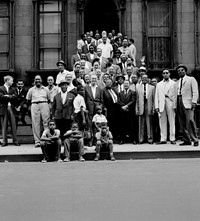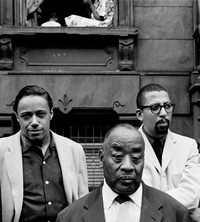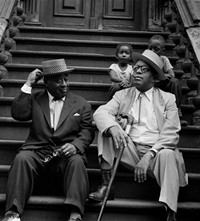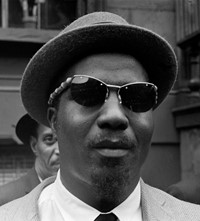Photographer Art Kane recounts the story behind ‘A Great Day in Harlem’, a legendary group portrait of Harlem’s jazz scene
- TextMiss Rosen
American photographer Art Kane was introduced to the idea of the “Big Picture” while serving as a member of the Ghost Army – a 1,100-man unit tasked with creating 20 battlefield deceptions, complete with dummy tanks and fake radio transmission to mislead the German Army during the 1944 invasion of Normandy. “The experience of creating something larger than life really stuck with him,” Jonathan Kane, his son, tells me.
By 1958, Kane was restless. At 27, he was the hot young art director for Seventeen magazine but he yearned to be a photographer. He got word Esquire was planning a special issue dedicated to jazz and decided to pitch his very first photography story: “A Great Day in Harlem,” which they accepted and published as the issue’s centerfold.
To celebrate the 60th anniversary of this legendary group portrait, one of the most celebrated images in American history, Jonathan Kane has put together the phenomenal book, Art Kane: Harlem 1958 (out this month via Wall of Sound Editions), featuring texts by Quincy Jones, Benny Golson, and Art Kane, as well as dozens of never-before-seen photographs of Dizzy Gillespie, Art Blakey, Thelonius Monk, Coleman Hawkins, Lester Young, Charles Mingus, Gerry Mulligan, Count Basie, and Gene Krupa, among others.
“It’s exciting to see the outtakes, and also rare,” Kane reveals. “My father did not believe in outtakes. He was about his one vision. I’m normally very protective but become bigger than even his original intention. The book is a journey through that day, and a revelation of the intimacy and connections between the musicians, and what is in the mind of a young photographer doing his first major professional assignment, and how it all crystallised in the ‘Big Picture.’”
Here, in an excerpt from the book, Art Kane looks back on this moment in time, as history was being made on the streets of Harlem.
“I came up with the idea of getting as many musicians together in one place as we could. It would be sort of a graduation photo or class picture of all the jazz musicians. After I thought about it some more I decided they should get together in Harlem. After all, that’s where jazz started when it came to New York….
So I made my request and a couple of weeks later it began to happen, right in front of my eyes. The next thing you know they all started moving into the block I’d picked out. I couldn’t believe it was happening….
The only thing was that I couldn’t control it, because we had all these musicians who hadn’t seen each other for a long time, some of them for months or even years. They were all talking and laughing and shaking hands and paying attention to each other, but not to this idiot kid across the street who had the audacity to set up the whole thing there.
I had never felt so alone before in my life, standing on the other side of the street watching them milling around and paying no attention at all to me. I was thinking, ‘Okay, Kane, you did it, now it’s your job to get them into some kind of formation for a picture.’
So I grabbed a copy of The New York Times and made it into a sort of megaphone and put it up to my mouth. I yelled and begged, ‘Please, please get together in some kind of formation. Move up into those steps up there in front of that house.’
Little by little, slowly but surely, they began moving up into the steps and filling up the front of the brownstone…. I have no idea how they decided to stand where they did, and with whom, but they did. Slowly they worked their way into position any way they saw fit, and I saw they couldn’t have gotten into any better position.
I knew from that moment on that this was what I wanted to do with my life. I wanted to be a photographer. That was what did it, the feeling of power from seeing those musicians moving up there onto those steps. And turning that moment into the Big Picture.”
Art Kane: Harlem 1958 is out now via Wall of Sound Editions.















